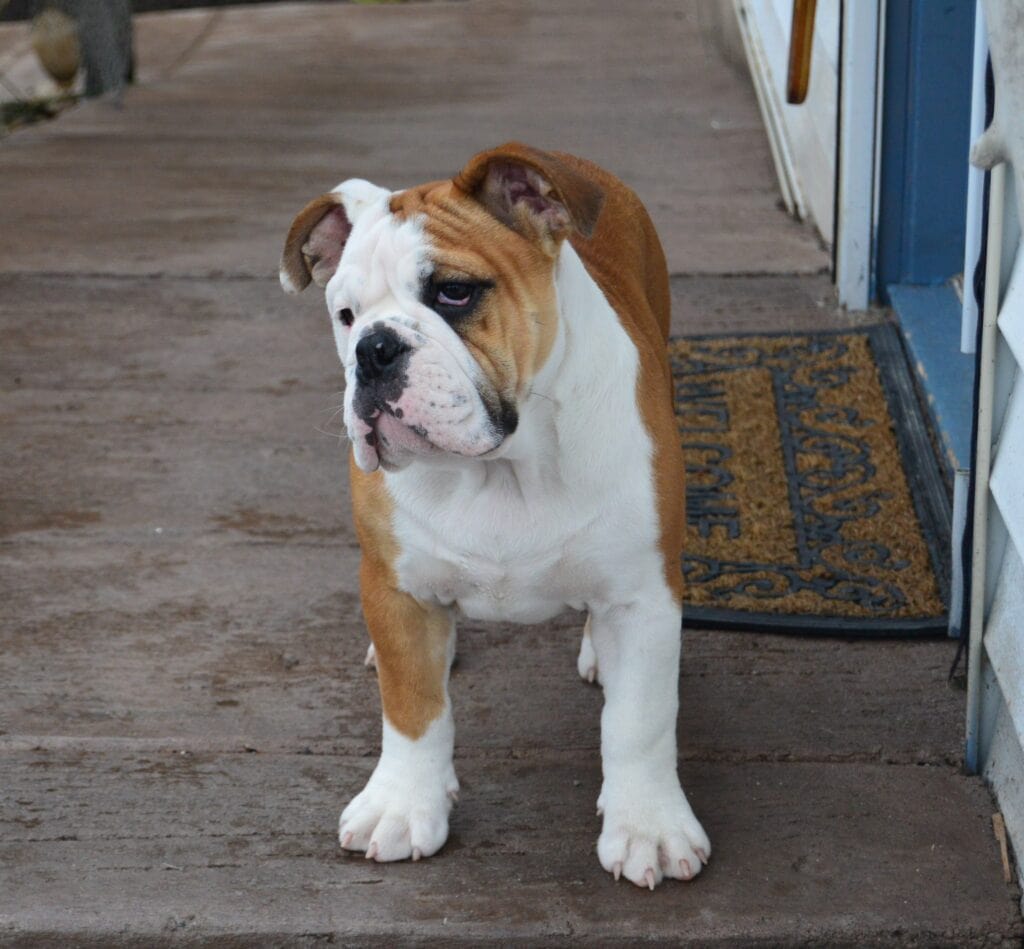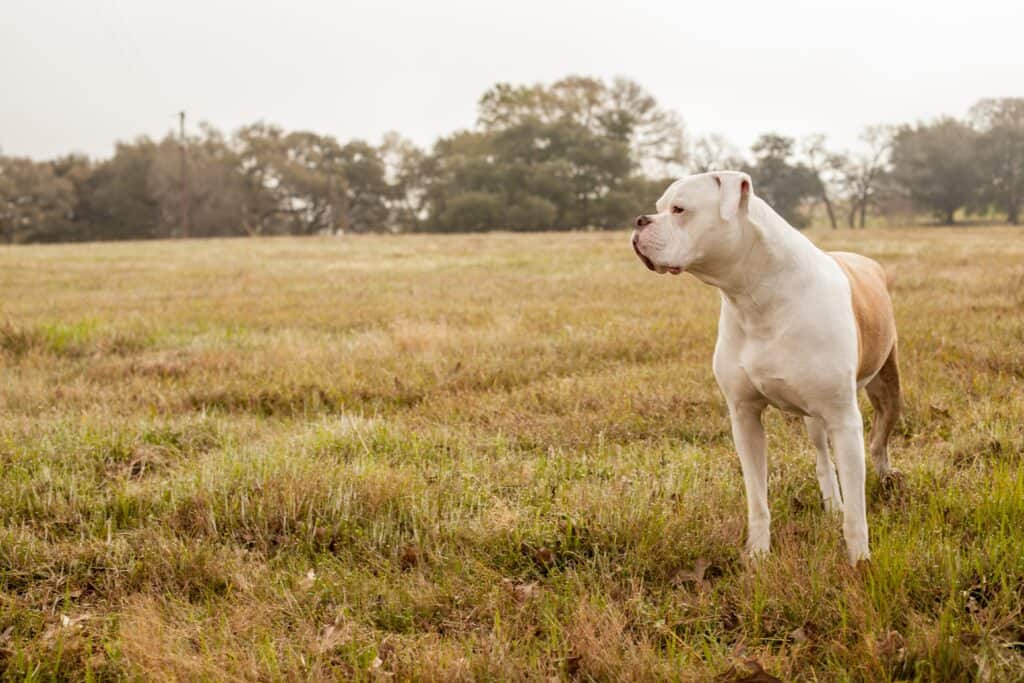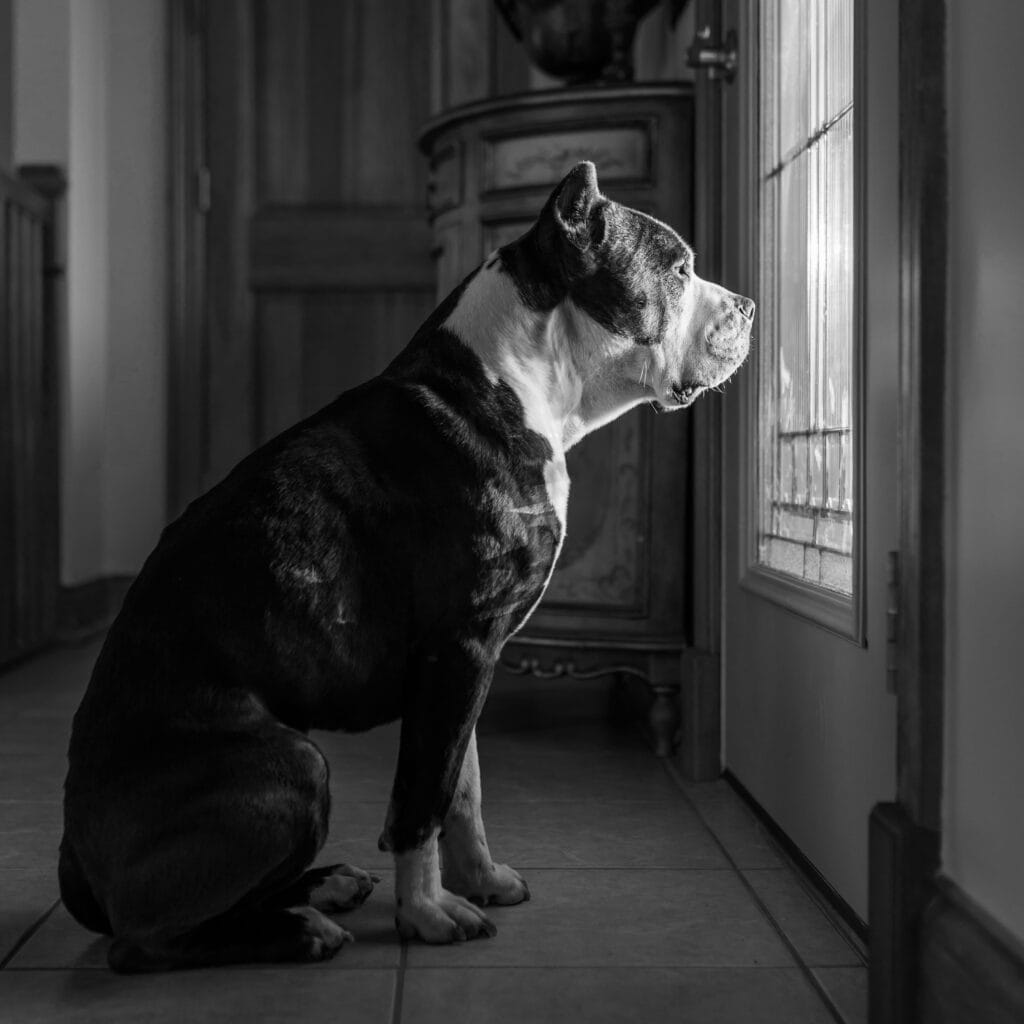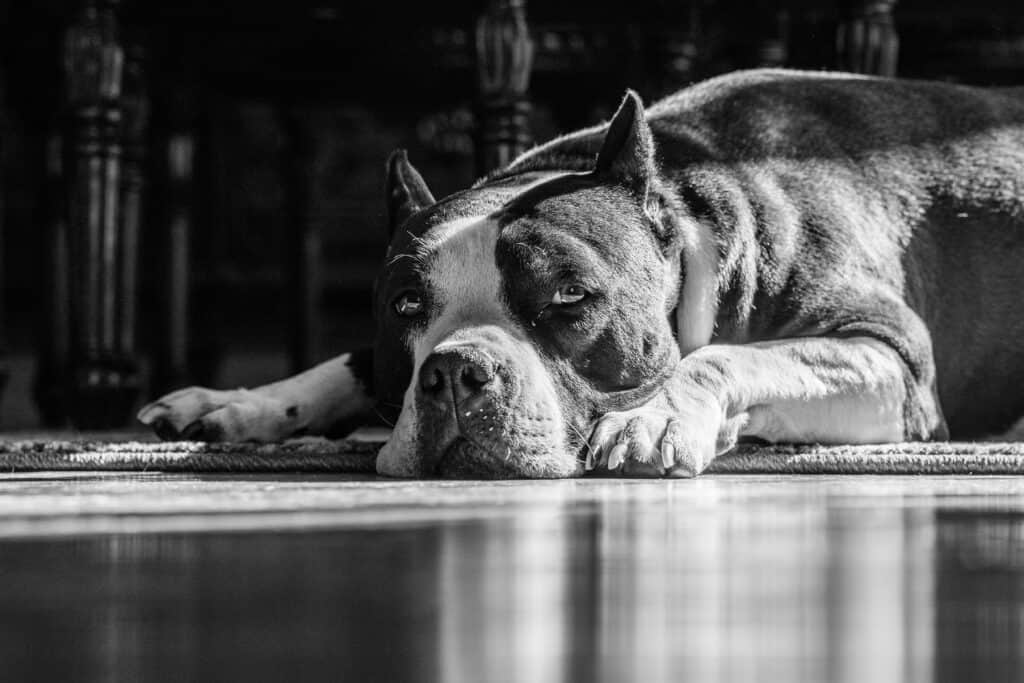Discover your ideal companion in our guide:
The American Bulldog vs. The American Bully – The Ultimate Breed Comparison.
Gain insights into origins, personalities, and distinctive traits, aiding your choice between these two incredible canines.
| Difference | American Bulldog | American Bully |
|---|---|---|
| Origin | United States | United States |
| Size Category | Large | Medium to Large |
| Height and Weight | Taller and heavier | Shorter but can be similar in weight |
| Build and Appearance | Muscular, rugged appearance | Stocky, compact build with a more blocky appearance |
| Head Structure | Broad, square-shaped head with well-defined jawline | Broad, blocky head with distinct stop and well-developed jaws |
| Ears and Tail | Can have rose or drop ears, natural or docked tail | May have cropped, semi-pricked, or drop ears, natural tail |
| Temperament and Use | Protective, versatile working dog | Affectionate companion, show dog, therapy roles |
| Coat Colors and Patterns | Various colors including white, brindle, fawn | Various colors, patterns including brindle, merle, tri-color |
| Energy Levels and Exercise Needs | High energy, requires more exercise | Moderate energy, still requires regular exercise |
| Breed Recognition | Recognized by various kennel clubs | Recognized by some kennel clubs, evolving in recognition |
The American Bulldog, historically valued as a working dog, displays a substantial and muscular physique, ideal for tasks such as guarding and hunting. Its robust frame embodies power and capability, with a notable head and sturdy build. In terms of temperament, American Bulldogs are known for their loyalty and protective nature, making them suitable as working dogs and family protectors.
In contrast, the American Bully showcases a stocky and compact build, carefully bred to exude a friendly and inviting appearance. This breed often exhibits a pronounced head and strong shoulders, enhancing its unique charm. American Bullies are primarily bred for companionship and are celebrated for their sociable and good-natured disposition, making them excellent family pets.
The difference between these breeds lies in their historical roles, physical characteristics, and temperaments, highlighting the versatility and diversity found in canine companions.
| Characteristic | Description |
|---|---|
| Size | Large to Giant |
| Weight (Male) | 70-120 pounds (32-54 kg) |
| Weight (Female) | 60-100 pounds (27-45 kg) |
| Height (Male) | 22-28 inches (56-71 cm) at the shoulder |
| Height (Female) | 20-26 inches (51-66 cm) at the shoulder |
| Body Type | Muscular, well-defined |
| Coat Type | Short, dense, and smooth |
| Coat Colors | White with patches of brindle, fawn, or brown |
| Head | Broad and square with a pronounced stop |
| Eyes | Almond-shaped, medium-sized, dark in color |
| Ears | Medium-sized, set high, can be cropped or natural |
| Nose | Black or brown |
| Muzzle | Broad and square |
| Lips | Slightly pendulous |
| Teeth | Strong, with a scissor bite |
| Neck | Thick and muscular |
| Chest | Deep and broad |
| Shoulders | Well-muscled and sloping |
| Legs | Strong and straight |
| Tail | Set low, thick at the base, tapers to a point, may be docked |
| Feet | Compact and well-arched |
| Gait | Agile and confident |
| Lifespan | 10-15 years |
| Temperament | Protective, loyal, confident, and alert |
| Exercise Needs | High |
| Trainability | Intelligent but can be stubborn |
| Health Concerns | Hip dysplasia, heart issues, skin problems, and obesity |
| Characteristic | Description |
|---|---|
| Size | Medium to Large |
| Weight (Male) | 70-120 pounds (32-54 kg) |
| Weight (Female) | 60-100 pounds (27-45 kg) |
| Height (Male) | 17-20 inches (43-51 cm) at the shoulder |
| Height (Female) | 16-19 inches (41-48 cm) at the shoulder |
| Body Type | Compact, muscular, and stocky |
| Coat Type | Short, glossy, and smooth |
| Coat Colors | Various colors and patterns, including solid, brindle, and more |
| Head | Large and blocky with a short, broad muzzle |
| Eyes | Round to oval, medium-sized, can be any color |
| Ears | Medium-sized, can be natural or cropped |
| Nose | Typically black or the same color as the coat |
| Muzzle | Basket Muzzles work best |
| Lips | Slightly pendulous, not overly loose |
| Teeth | Strong with a scissor bite |
| Neck | Thick and muscular |
| Chest | Deep and broad |
| Shoulders | Wide and well-muscled |
| Legs | Straight and strong |
| Tail | Short and tapered, may be docked or natural |
| Feet | Compact with well-arched toes |
| Gait | Confident and agile |
| Lifespan | 10-12 years |
| Temperament | Friendly, affectionate, and good with families |
| Exercise Needs | Moderate to high |
| Trainability | Intelligent and eager to please |
| Health Concerns | Hip dysplasia, heart issues, skin problems, and obesity |
Woof Mastery is reader supported and our articles may contain affiliate links.
Instead of running third party ads that we have no control of we only use links from high-quality companies we are directly partnered with. Making use of these links come at no cost to you our reader, and in many cases have the extra benefit of discounted rates or sign up bonuses.
If you’re interested you can read more about our affiliate policy here.
We appreciate your support and always insure that the products and services we recommend are high-quality, helpful and relevant to the subject at hand!

American Bullies
American Bullies excel as family dogs, especially with kids, thanks to their affectionate nature, patience, and playful disposition.
They form strong bonds with their human family members and engage in interactive play gently. Their manageable size and loyalty make them a popular choice for families.
In contrast, American Bulldogs, while loyal, can be more assertive and physically imposing, which may not align as well with the active playstyle of children.
The American Bulldog
The American Bulldog may pose a higher risk to neighbors and other people due to its protective and territorial nature. Without proper training and socialization, these traits can lead to a more assertive and potentially aggressive demeanor, potentially increasing the risk of physical harm to others.
In contrast, American Bullies typically have a more friendly and approachable disposition, which may result in fewer issues in terms of aggression towards neighbors and unfamiliar individuals.
The American Bully
Their eager-to-please nature and high intelligence make them quick learners, often responding well to consistent and positive training methods. American Bullies are often more adaptable to different training styles, which can be advantageous for novice dog owners.
On the other hand, while American Bulldogs are intelligent, their strong-willed and independent temperament can sometimes present challenges in training. They may require more experienced handlers who can provide firm but gentle guidance to achieve the desired results.
The American Bulldog
American Bulldogs tend to have a higher risk profile compared to American Bullies.
American Bulldogs are prone to certain breed-specific health issues, such as hip dysplasia, elbow dysplasia, and respiratory problems. Their larger size and specific breeding characteristics can make them more susceptible to these conditions.
In contrast, American Bullies, being a relatively newer breed with a more diverse genetic background, may have fewer breed-specific health concerns, although individual health can still vary depending on genetics, diet, and overall care. Nevertheless, both breeds benefit from responsible breeding practices, regular veterinary care, and a healthy lifestyle to mitigate potential health risks.
The American Bulldog
American Bulldogs have higher energy levels and require more daily exercise and mental stimulation to stay happy and healthy. They were originally bred for working purposes and have retained their active nature. In contrast, while American Bullies also need regular exercise and playtime, they generally have a slightly lower activity level and may be better suited for families in urban or less active settings.
The activity level can vary among individual dogs within each breed, so it’s essential to assess the specific needs of the dog in question.
The American Bulldog, with its rich history deeply intertwined with agricultural life, has also seamlessly adapted to the demands of modern society.
While its heritage as a versatile farm dog remains a captivating part of its story, these dogs have shown a remarkable ability to evolve and thrive in changing times. In the past, American Bulldogs were the unsung heroes of farms, performing various tasks from livestock protection to pest control. Today, their versatile nature finds new expression in different roles within our contemporary world.
They have transitioned from rural farms to become cherished companions, loyal family pets, and even therapy dogs, showcasing their adaptability and gentle temperament.
Their protective instincts, once essential for safeguarding livestock, now make them excellent watchdogs, providing security to modern households. Additionally, their affectionate nature and unwavering loyalty have endeared them to families, making them wonderful companions for people of all ages. Moreover, American Bulldogs have not lost their sense of adventure and physical prowess. Many still excel in canine sports, showcasing their agility and strength in activities such as agility courses and weight-pulling competitions.
As we admire the American Bulldog’s enduring legacy in agriculture, we also celebrate their resilience and adaptability in a world that continues to change. These dogs continue to find new and meaningful roles in our lives, demonstrating their enduring value as loyal and versatile companions.

American bulldogs can be protective, confident, and assertive, making them wary of strangers and potentially less sociable with other dogs.
They generally exhibit a lot more guarding instincts than your average American Bully.
American Bulldogs are larger and more muscular, with a strong and athletic build. Their distinct color patterns and sturdy build, make them almost impossible not to identify from a glance.
While not much bigger than the American Bully, they do have greater needs for exercise and movement.
Enter The Woof Mastery
The American Bully breed, born from a lineage of working dogs, has seamlessly adapted to the dynamic landscape of modern society while carrying forward its fascinating history.
Beyond their historical roots, these dogs have demonstrated an impressive ability to evolve and thrive in changing times. Originating from American Pit Bull Terriers and American Staffordshire Terriers, American Bullies have transitioned from their historical roles as working and farm dogs to become beloved members of families in the contemporary world. Their transformation showcases their remarkable adaptability and friendly disposition.
Once renowned for their strength and tenacity, American Bullies now stand out as affectionate and loyal family pets. Their protective instincts, once crucial for farm work and hunting, have evolved into being vigilant guardians of households, offering a sense of security to their owners. In addition to their role as family protectors, American Bullies have found new avenues for their physical prowess. Many excel in dog sports like weight-pulling competitions, agility, and even therapy work, utilizing their strength and intelligence in engaging and meaningful ways.
The American Bully’s history as a breed with a strong work ethic and physical prowess is still evident today, but they have gracefully adapted to modern life as cherished companions.
Their journey from the farmyard to family homes exemplifies their resilience and enduring value in our ever-changing world.

American bulldogs can be protective, confident, and assertive, making them wary of strangers and potentially less sociable with other dogs.
They generally exhibit a lot more guarding instincts than your average American Bully.
American Bulldogs are larger and more muscular, with a strong and athletic build. Their distinct color patterns and sturdy build, make them almost impossible not to identify from a glance.
While not much bigger than the American Bully, they do have greater needs for exercise and movement.

It’s a tie!
American Bullies and American Bulldogs are generally considered to be of similar intelligence. However, intelligence can vary among individuals within each breed, and it’s important to remember that intelligence alone doesn’t determine a dog’s behavior or suitability as a pet.
Both breeds can excel in obedience and training with the right approach and consistent, positive reinforcement.
American Bullies
The American Bully typically has a longer lifespan, averaging between 10 to 12 years.
In contrast, American Bulldogs tend to have a shorter lifespan, often around 10 years.
Longevity can also vary based on factors like genetics, diet, and overall care, so look after your pup if you want to spend more time with it!
It’s Another Tie
Both American Bullies and American Bulldogs have short coats that shed moderately. Neither breed is particularly known for excessive shedding, and grooming practices can help manage shedding for both. However, the extent of shedding can still vary among individual dogs within each breed.
Both have a light risk
Beyond owner error both American Bullies and American Bulldogs, may face breed-specific restrictions or requirements based on the airline’s policies.
These restrictions are often related to the breed’s brachycephalic (flat-faced) characteristics, which can pose respiratory challenges during flights. While usually not an issue, both breeds may be considered at a slightly higher risk due to these characteristics.
The specific risks associated with air travel can vary by airline and the individual dog’s health and well-being. It’s crucial for pet owners to research airline policies and consult with veterinarians to ensure the safety and comfort of their pets during air travel.
The American Bully!
When it comes to compatibility with other dogs, American Bullies often have an advantage. Their inherently friendly and sociable nature makes them more adaptable to interacting with other canines. They tend to exhibit a playful and approachable demeanor, which can facilitate positive interactions in multi-dog households.
This friendly disposition often extends to their behavior at dog parks or during group playdates, where they are more likely to engage in harmonious play and socialize comfortably with other dogs.
Conversely, while American Bulldogs are also loyal and can form strong bonds with their families, their temperament may lean more towards assertiveness and protectiveness. This can sometimes lead to challenges when introducing them to other dogs, particularly those they perceive as potential threats to their family unit.
That said, with proper training and socialization from an early age, many American Bulldogs can learn to coexist peacefully with other dogs.
Woof Mastery is reader supported and our articles may contain affiliate links.
Instead of running third party ads that we have no control of we only use links from high-quality companies we are directly partnered with. Making use of these links come at no cost to you our reader, and in many cases have the extra benefit of discounted rates or sign up bonuses.
If you’re interested you can read more about our affiliate policy here.
We appreciate your support and always insure that the products and services we recommend are high-quality, helpful and relevant to the subject at hand!
American Bullies are often recognized for their friendly and affectionate temperament, making them excellent family pets. They tend to be loyal, eager to please, and typically get along well with children and other pets. Their gentle and patient nature often contributes to a harmonious home environment.
American Bulldogs, while also known for their loyalty, can have a more assertive and protective temperament. This protective instinct can be advantageous in certain situations but may require experienced handling and socialization to ensure that they interact well with other animals and strangers.
Ultimately, the choice of which breed has a better temperament depends on individual preferences and lifestyle. American Bullies are often chosen for their affectionate and family-friendly disposition, while American Bulldogs can be suitable for those seeking a more protective and confident companion. Proper training and socialization are essential for both breeds to bring out the best in their temperaments.
Both American Bullies and American Bulldogs have the capacity to bark, but the frequency and intensity of barking can vary among individual dogs and are influenced by factors like training and socialization. Excessive barking is not typically a defining characteristic of either breed.
Environmental conditions, socialization, and training play significant roles in shaping a dog’s barking behavior. With appropriate training and attention to their specific needs, owners can generally manage and reduce excessive barking in both breeds.
American Bullies are often considered more suitable for apartment living compared to American Bulldogs.
Their medium size and adaptable nature make them well-suited to urban environments with limited space. American Bullies generally have lower energy levels than American Bulldogs, making them more comfortable with a more relaxed indoor lifestyle.
It still remains essential to provide both breeds with regular exercise and mental stimulation, even in apartment settings, to ensure their well-being and prevent behavioral issues. Additionally, proper socialization and adherence to any breed-specific regulations in apartment complexes are important considerations for responsible pet ownership in such settings.
American Bulldogs
When it comes to guard dogs, American Bulldogs are generally considered to be better suited for this role compared to American Bullies. American Bulldogs have a protective and assertive nature, combined with physical strength, making them effective at guarding property and alerting their owners to potential threats. Their loyalty and vigilance are valuable traits in a guard dog.
On the other hand, American Bullies, while protective of their families, tend to have a friendlier and more sociable disposition. They are less likely to exhibit the guarding instincts and aggression towards strangers that are typically desired in a guard dog.
With proper training and socialization, both breeds can fulfill a guarding role, but American Bulldogs are often preferred for their inherent protective instincts.
Both American Bullies and American Bulldogs have similar dietary requirements, and there isn’t a significant difference in the ease of their diets.
Their nutritional needs are influenced by factors such as age, size, activity level, and any specific health concerns. Providing a balanced diet with high-quality dog food appropriate for their life stage and consulting with a veterinarian to address any breed-specific health considerations is essential for both breeds.
The ease of managing their diet depends more on individual preferences and dietary restrictions than on their breed type.
In conclusion, our exploration of the American Bulldog and the American Bully highlights the presence of two distinct yet exceptional breeds, each possessing its own set of remarkable qualities. The American Bulldog is characterized by its robust, loyal nature, embodying a deep sense of protectiveness and a strong bond with its family. Conversely, the American Bully stands out for its friendly, adaptable demeanor, making it an approachable and sociable companion.
The choice between these breeds should be thoughtfully tailored to your lifestyle, expectations, and needs. Both the American Bulldog and the American Bully can thrive in the right environment and under responsible ownership. It’s important to underscore that responsible ownership and ethical breeding practices play a pivotal role in ensuring the well-being and happiness of any breed.
Whether you opt for the American Bulldog or the American Bully, both breeds possess the potential to become cherished, lifelong companions for those willing to invest time, effort, and care into their upbringing and training. Ultimately, it is the bond you foster and the love and attention you provide that will define the rewarding journey you embark upon with your chosen four-legged friend.